Assessment of Spatial Equality and Social Justice of Urban Park Distribution from Park Category Perspective: Evidence from Shanghai, China
Abstract
1. Introduction
2. Materials and Methods
2.1. Study Area and Data Sources
2.1.1. Study Area
2.1.2. Urban Park Categories
2.1.3. Data Sources
- The Seventh National Census of China’s 2020 geographic dataset for census tract boundaries, demographic statistics, and sub-district boundaries. The demographic statistics include the total resident population, the elder population (over 60 years old), and children/youth (under 18 years old) (Figure 2).
- Relative planning schemes provided by the local government of Xuhui District, including the 14th Five-Year Plan for Landscaping and City Appearance of Xuhui District, the Regulatory Unit Planning of Xuhui District (2022), the Urban Greenland Classification Standard (CJJ/T85-2017), the Urban Greenland Planning Standard (GB/T 51346-2019), and the Shanghai Urban Master Planning Scheme (2017–2035).
- Remote sensing data of parkland, which were enclosed in the Remote Sensing Investigation Report of Green Spaces in Xuhui District (Figure 3).
- On-site investigations of existing urban parks and the housing prices of each neighborhood. The housing prices of 651 residential communities were recorded.
2.2. Methods
2.2.1. Measurement of Spatial Equality
- Urban Park Accessibility (UPA)
2.2.2. Measurement of Social Justice
2.2.3. Analyses
- Local indicators of spatial association (LISA) for spatial inequality
- Non-parametric analyses of Kruskal–Wallis H test for social injustice
3. Results
3.1. Measuring Spatial Equality Based on All Urban Park Categories
3.1.1. Spatial Characteristics of Urban Park Accessibility (UPA)
3.1.2. The Distribution of Communities with Low Versus High Access to Urban Parks Using LISA
3.2. Measuring Social Justice Based on Three Categories of Urban Parks
3.2.1. Social Justice Related to Elder People and Young People
3.2.2. Social Justice Related to Low-Income People
4. Discussion
4.1. The Overall Distribution of Urban Parks Exhibits a Certain Degree of Inequity
4.2. Priority Groups in Xuhui District Need More Attention
4.3. Leveling Pocket Parks for the Priority Population
5. Conclusions
Author Contributions
Funding
Data Availability Statement
Acknowledgments
Conflicts of Interest
Abbreviations
| UPA | Urban Park Accessibility |
| SLQP | Service Location Quotient per Capita |
| 2SFCA | Two-Step Floating Catchment Area |
| SLQP_E | Service Location Quotient per Capita of Elder People |
| SLQP_Y | Service Location Quotient per Capita of Young People |
| SLQP_LI_SD | Per Capita Park Service of Low-Income Communities with Average Level of Sub-district |
| SLQP_LI_D | Per Capita Park Service of Low-Income Communities with Average Level of District |
| LISAs | Local Indicators of Spatial Association |
| SLQP_LI | Service Location Quotient per Capita of Low-Income People |
References
- Cohen, P.; Potchter, O.; Schnell, I. The impact of an urban park on air pollution and noise levels in the Mediterranean city of Tel-Aviv, Israel. Environ. Pollut. 2014, 195, 73–83. [Google Scholar] [CrossRef] [PubMed]
- Jim, C.Y.; Chen, W.Y. Assessing the ecosystem service of air pollutant removal by urban trees in Guangzhou (China). J. Environ. Manag. 2008, 88, 665–676. [Google Scholar] [CrossRef] [PubMed]
- Chiesura, A. The Role of Urban Parks for the Sustainable City. Landsc. Urban Plan. 2004, 68, 129–138. [Google Scholar] [CrossRef]
- Chen, Q.; Du, M.; Cheng, Q.; Jing, C. Quantitative Evaluation of Spatial Differentiation for Public Open Spaces in Urban Built-Up Areas by Assessing SDG 11.7: A Case of Deqing County. ISPRS Int. J. Geo-Inf. 2020, 9, 575. [Google Scholar] [CrossRef]
- Lee, A.; Maheswaran, R. The health benefits of urban green spaces: A review of the evidence. J. Public Health 2011, 33, 212–222. [Google Scholar] [CrossRef]
- Lu, Y.; Rigolon, A.; Carver, S.; Wu, J. Data augmented planning: A data-driven approach to measuring-understanding-optimizing green justice across 263 Chinese cities. Sustain. Cities Soc. 2024, 117, 105981. [Google Scholar] [CrossRef]
- Cutts, B.; Darby, K.J.; Boone, C.G.; Brewis, A. City structure, obesity, and environmental justice: An integrated analysis of physical and social barriers to walkable streets and park access. Soc. Sci. Med. 2009, 69, 1314–1322. [Google Scholar] [CrossRef]
- Wolch, J.R.; Byrne, J.A.; Newell, J.P. Urban green space, public health, and environmental justice: The challenge of making cities ‘just green enough’. Landsc. Urban Plan. 2014, 125, 234–244. [Google Scholar] [CrossRef]
- Hay, A.M. Concepts of Equity, Fairness and Justice in Geographical Studies. Trans. Inst. Br. Geogr. 1995, 20, 500–508. [Google Scholar] [CrossRef]
- Tang, Z.; Gu, S. An Evaluation of Social Performance in the Distribution of Urban Parks in the Central City of Shanghai: From Spatial Equity to Social Equity. Urban Plan. Forum. 2015, 222, 48–56. [Google Scholar]
- Jiang, H.; Zhou, C.; Gao, J. Advance in the equity of spatial distribution of urban public service in western countries. City Plan. 2011, 35, 72–77. [Google Scholar]
- Chang, H.-S.; Liao, C.-H. Exploring an integrated method for measuring the relative spatial equity in public facilities in the context of urban parks. Cities 2011, 28, 361–371. [Google Scholar] [CrossRef]
- Lee, G.; Hong, I. Measuring spatial accessibility in the context of spatial disparity between demand and supply of urban park service. Landsc. Urban Plan. 2013, 119, 85–90. [Google Scholar] [CrossRef]
- Huang, Y.; Hong, X.; Zheng, Y.; Zhang, Y.; Li, Z. Assessment and optimization of spatial equity for urban parks: A case study in Nanjing, China. Ecol. Indic. 2024, 166, 112449. [Google Scholar] [CrossRef]
- Xiao, Y.; Wang, Z.; Li, Z.; Tang, Z. An assessment of urban park access in Shanghai—Implications for the social equity in urban China. Landsc. Urban Plan. 2017, 157, 383–393. [Google Scholar] [CrossRef]
- Xiao, Y.; Wang, D.; Fang, J. Exploring the disparities in park access through mobile phone data: Evidence from Shanghai, China. Landsc. Urban Plan. 2019, 181, 80–91. [Google Scholar] [CrossRef]
- Shen, Y.; Sun, F.; Che, Y. Public green spaces and human wellbeing: Mapping the spatial inequity and mismatching status of public green space in the Central City of Shanghai. Urban For. Urban Green. 2017, 27, 59–68. [Google Scholar] [CrossRef]
- Rigolon, A. A complex landscape of inequity in access to urban parks: A literature review. Landsc. Urban Plan. 2016, 153, 160–169. [Google Scholar] [CrossRef]
- Kim, E.K.; Yoon, S.; Jung, S.U.; Kweon, S.J. Optimizing urban park locations with addressing environmental justice in park access and utilization by using dynamic demographic features derived from mobile phone data. Urban For. Urban Green. 2024, 99, 128444. [Google Scholar] [CrossRef]
- Byrne, J.; Wolch, J. Nature, Race, and Parks: Past Research and Future Directions for Geographic Research. Prog. Hum. Geogr. 2009, 33, 743–765. [Google Scholar] [CrossRef]
- Kabisch, N.; Haase, D. Green justice or just green? Provision of urban green spaces in Berlin, Germany. Landsc. Urban Plan. 2014, 122, 129–139. [Google Scholar] [CrossRef]
- Kronenberg, J.; Haase, A.; Łaszkiewicz, E.; Antal, A.; Baravikova, A.; Biernacka, M.; Dushkova, D.; Filčak, R.; Haase, D.; Ignatieva, M.; et al. Environmental justice in the context of urban green space availability, accessibility, and attractiveness in post socialist cities. Cities 2020, 106, 102862. [Google Scholar] [CrossRef]
- Zeng, P.; Sun, F.; Liu, Y.; Chen, C.; Tian, T.; Dong, Q.; Che, Y. Significant social inequalities exist between hot and cold extremes along urban-rural gradients. Sustain. Cities Soc. 2022, 82, 103899. [Google Scholar] [CrossRef]
- Zeng, P.; Sun, F.; Shi, D.; Liu, Y.; Zhang, R.; Tian, T.; Che, Y. Integrating anthropogenic heat emissions and cooling accessibility to explore environmental justice in heat-related health risks in Shanghai, China. Landsc. Urban Plan. 2022, 226, 104490. [Google Scholar] [CrossRef]
- Loebach, J.; Gilliland, J. Free Range Kids? Using GPS-Derived Activity Spaces to Examine Children’s Neighborhood Activity and Mobility. Environ. Behav. 2014, 48, 421–453. [Google Scholar] [CrossRef]
- Pleson, E.; Nieuwendyk, L.M.; Lee, K.K.; Chaddah, A.; Nykiforuk, C.I.; Schopflocher, D. Understanding Older Adults’ Usage of Community Green Spaces in Taipei, Taiwan. Int. J. Environ. Res. Public Health 2014, 11, 1444–1464. [Google Scholar] [CrossRef]
- Chawla, L. Benefits of Nature Contact for Children. J. Plan. Lit. 2015, 30, 433–452. [Google Scholar] [CrossRef]
- De Sousa Silva, C.; Viegas, I.; Panagopoulos, T.; Bell, S. Environmental Justice in Accessibility to Green Infrastructure in Two European Cities. Land 2018, 7, 134. [Google Scholar] [CrossRef]
- Brulle, R.J.; Pellow, D.N. Environmental justice: Human health and environmental inequalities. Annu. Rev. Public Health 2006, 27, 103–124. [Google Scholar] [CrossRef]
- Rigolon, A. Parks and young people: An environmental justice study of park proximity, acreage, and quality in Denver, Colorado. Landsc. Urban Plan. 2017, 165, 73–83. [Google Scholar] [CrossRef]
- Talen, E. Who can walk? An analysis of public amenity access in America’s ten largest cities. Environ. Plan. B Urban Anal. City Sci. 2022, 50, 1775–1789. [Google Scholar] [CrossRef]
- La Rosa, D.; Takatori, C.; Shimizu, H.; Privitera, R. A planning framework to evaluate demands and preferences by different social groups for accessibility to urban greenspaces. Sustain. Cities Soc. 2018, 36, 346–362. [Google Scholar] [CrossRef]
- Wen, C.; Albert, C.; Von Haaren, C. Equality in access to urban green spaces: A case study in Hannover, Germany, with a focus on the elderly population. Urban For. Urban Green. 2020, 55, 126820. [Google Scholar] [CrossRef]
- Gong, F.; Zheng, Z.-C.; Ng, E. Modeling Elderly Accessibility to Urban Green Space in High Density Cities: A Case Study of Hong Kong. Procedia Environ. Sci. 2016, 36, 90–97. [Google Scholar] [CrossRef]
- Zhou, C.; Zhang, Y.; Fu, L.; Xue, Y.; Wang, Z. Assessing mini-park installation priority for regreening planning in densely populated cities. Sustain. Cities Soc. 2021, 67, 102716. [Google Scholar] [CrossRef]
- Xiao, Y.; Lu, Y.; Guo, Y.; Yuan, Y. Estimating the willingness to pay for green space services in Shanghai: Implications for social equity in urban China. Urban For. Urban Green. 2017, 26, 95–103. [Google Scholar] [CrossRef]
- CJJ/T 85-2017; Urban Greenland Classification Standard. China Architecture & Building Press: Beijing, China, 2017.
- GB/T 51346-2019; Urban Greenland Planning Standard. China Architecture & Building Press: Beijing, China, 2019.
- La Rosa, D. Accessibility to greenspaces: GIS based indicators for sustainable planning in a dense urban context. Ecol. Indic. 2014, 42, 122–134. [Google Scholar] [CrossRef]
- Gupta, K.; Roy, A.; Luthra, K.; Maithani, S. GIS based analysis for assessing the accessibility at hierarchical levels of urban green spaces. Urban For. Urban Green. 2016, 18, 198–211. [Google Scholar] [CrossRef]
- Biernacka, M.; Kronenberg, J. Classification of institutional barriers affecting the availability, accessibility and attractiveness of urban green spaces. Urban For. Urban Green. 2018, 36, 22–33. [Google Scholar] [CrossRef]
- Wu, J.; Chen, H.; Wang, H.; He, Q.; Zhou, K. Will the opening community policy improve the equity of green accessibility and in what ways?—Response based on a 2-step floating catchment area method and genetic algorithm. J. Clean. Prod. 2020, 263, 121454. [Google Scholar] [CrossRef]
- Xing, L.; Liu, Y.; Wang, B.; Wang, Y.; Liu, H. An environmental justice study on spatial access to parks for youth by using an improved 2SFCA method in Wuhan, China. Cities 2020, 96, 102405. [Google Scholar] [CrossRef]
- Ren, X.; Guan, C. Evaluating geographic and social inequity of urban parks in Shanghai through mobile phone-derived human activities. Urban For. Urban Green. 2022, 76, 127709. [Google Scholar] [CrossRef]
- GB50180-2018; Urban Residential Area Planning and Design Standard. China Architecture & Building Press: Beijing, China, 2018.
- Miller, M.M.; Gibson, L.J.; Wright, N.G. Location quotient: A basic tool for economic development analysis. Econ. Dev. Rev. 1991, 9, 65. [Google Scholar]
- Dang, H.; Li, J.; Zhang, Y.; Zhou, Z. Evaluation of the Equity and Regional Management of Some Urban Green Space Ecosystem Services: A Case Study of Main Urban Area of Xi’an City. Forests 2021, 12, 813. [Google Scholar] [CrossRef]
- Talen, E. The Social Equity of Urban Service Distribution: An Exploration of Park Access in Pueblo, Colorado, And Macon, Georgia. Urban Geogr. 1997, 18, 521–541. [Google Scholar] [CrossRef]
- Li, H.; Wang, Q.; Shi, W.; Deng, Z.; Wang, H. Residential clustering and spatial access to public services in Shanghai. Habitat Int. 2015, 46, 119–129. [Google Scholar] [CrossRef]
- Anselin, L. Local Indicators of Spatial Association—LISA. Geogr. Anal. 1995, 27, 93–115. [Google Scholar] [CrossRef]
- Anselin, L. The Moran scatterplot as an ESDA tool to assess local instability in spatial association. In Spatial Analytical Perspectives on GIS; Routledge: Oxfordshire, UK, 1996. [Google Scholar]
- Zhang, R.; Zhang, C.Q.; Cheng, W.; Lai, P.C.; Schüz, B. The neighborhood socioeconomic inequalities in urban parks in a High-density City: An environmental justice perspective. Landsc. Urban Plan. 2021, 211, 104099. [Google Scholar] [CrossRef]
- Wu, H.; Wang, L.; Zhang, Z.; Gao, J. Analysis and optimization of 15-minute community life circle based on supply and demand matching: A case study of Shanghai. PLoS ONE 2021, 16, e0256904. [Google Scholar] [CrossRef]

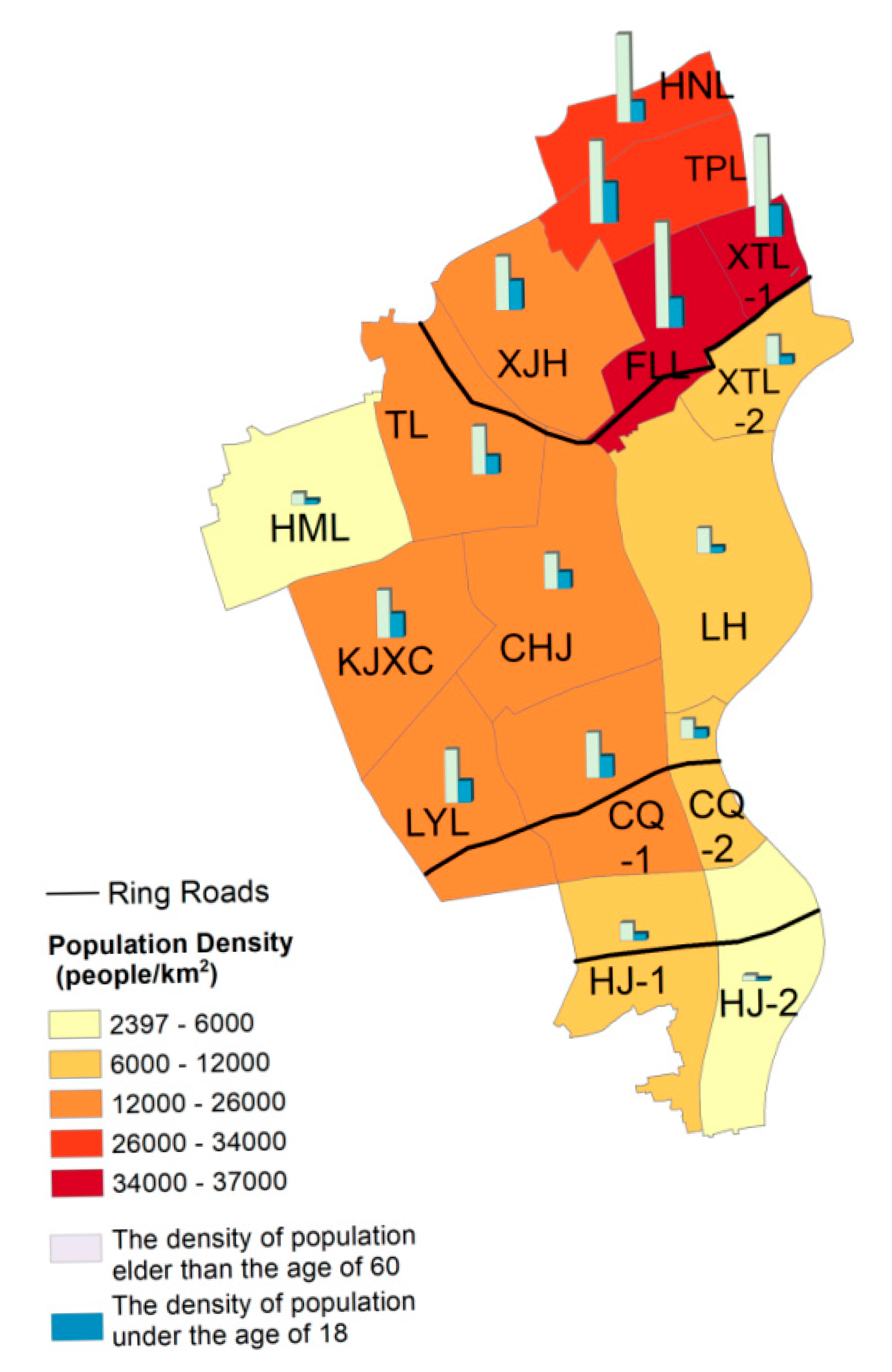
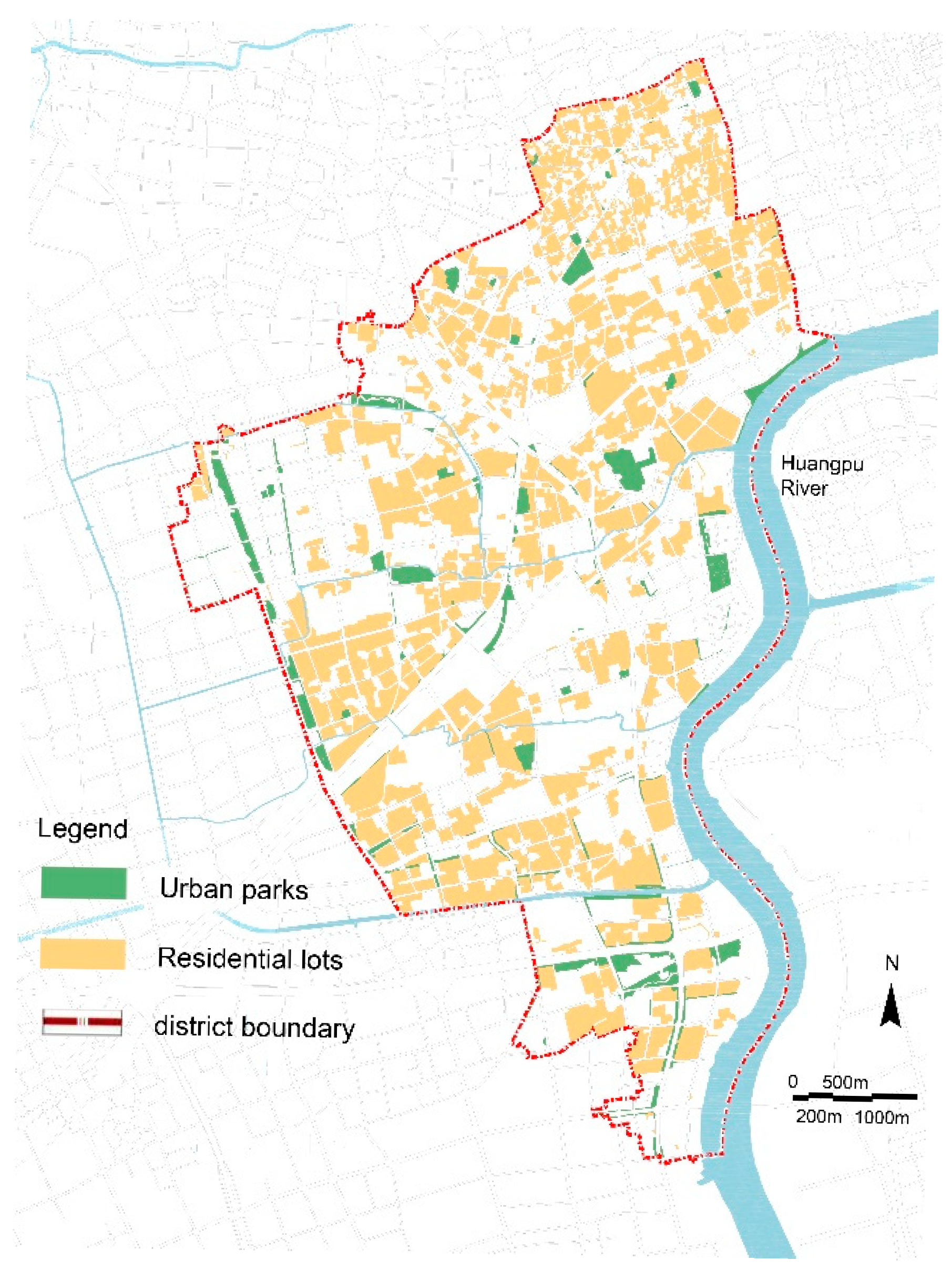
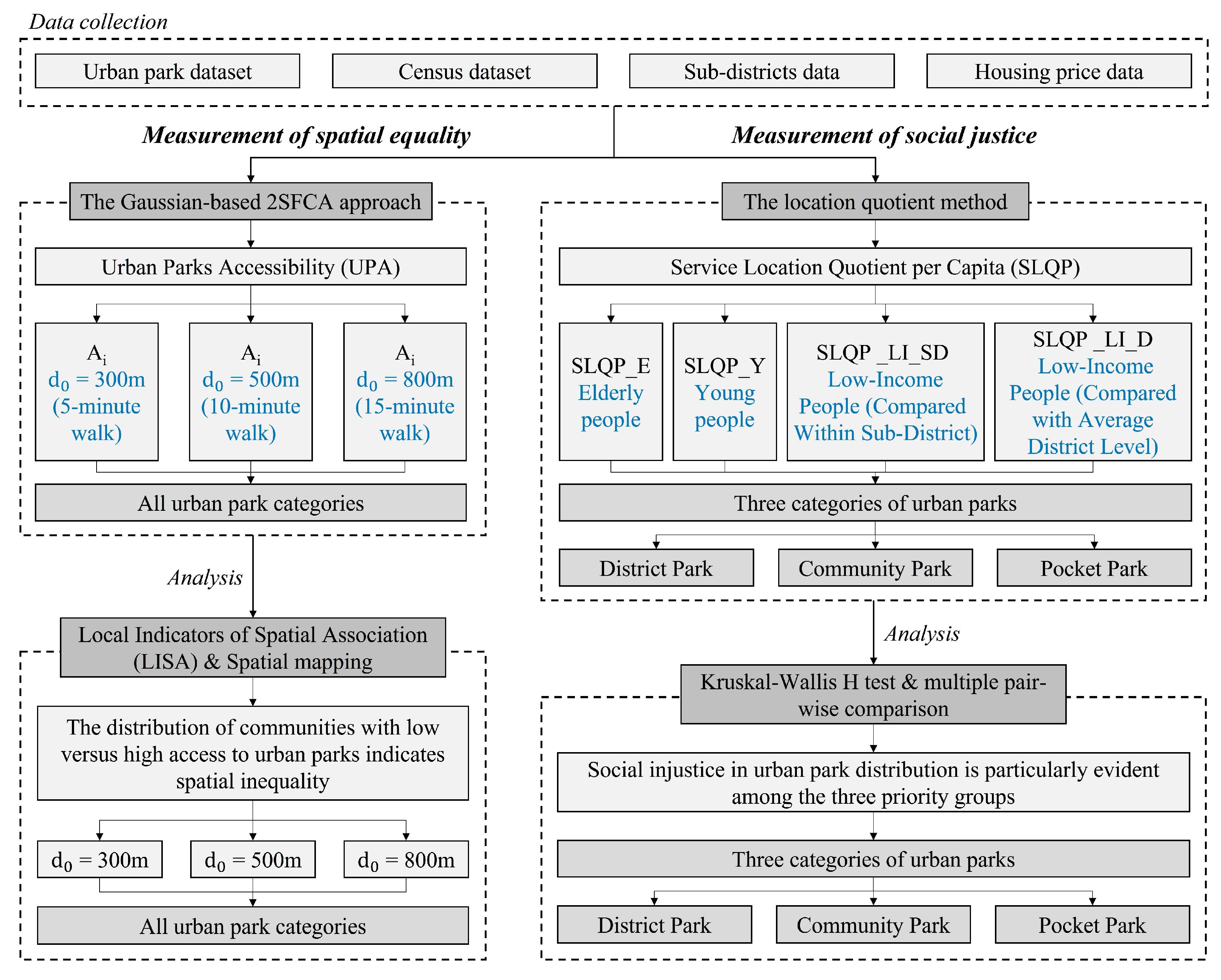
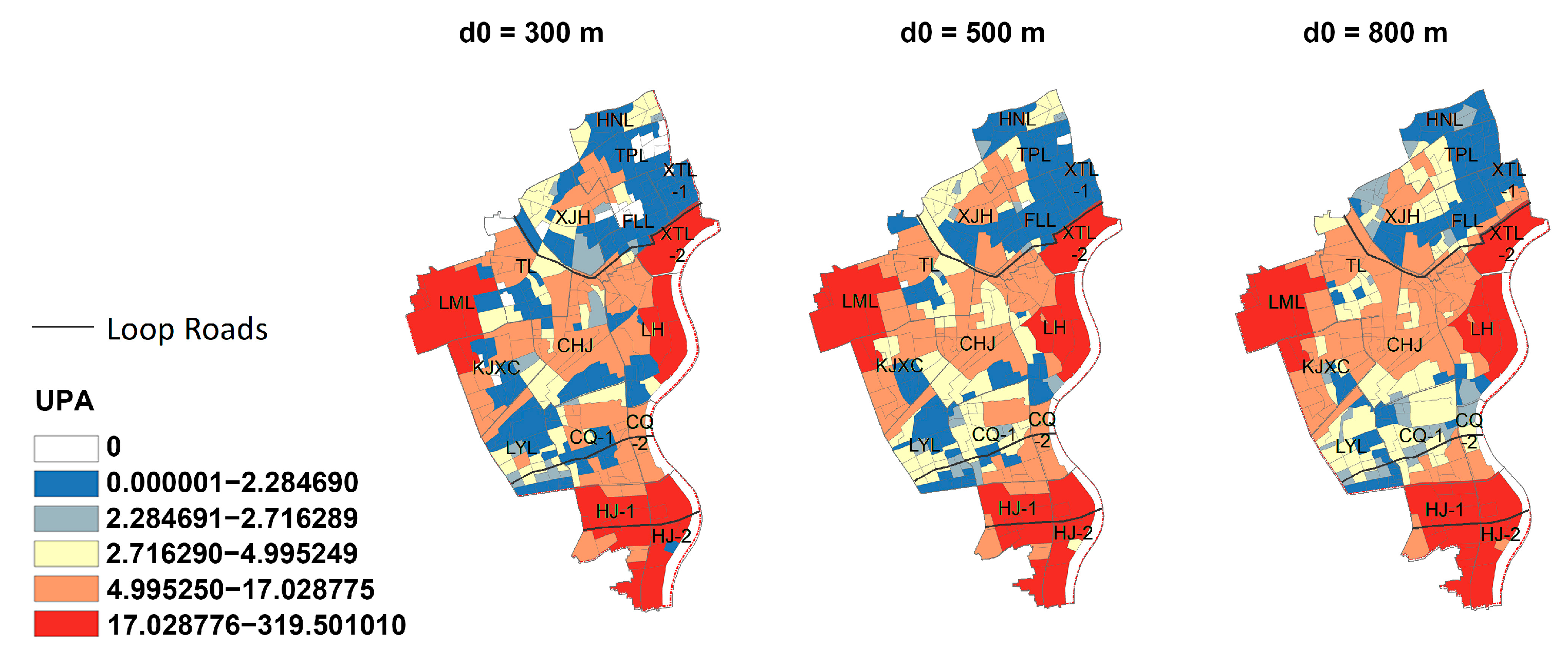
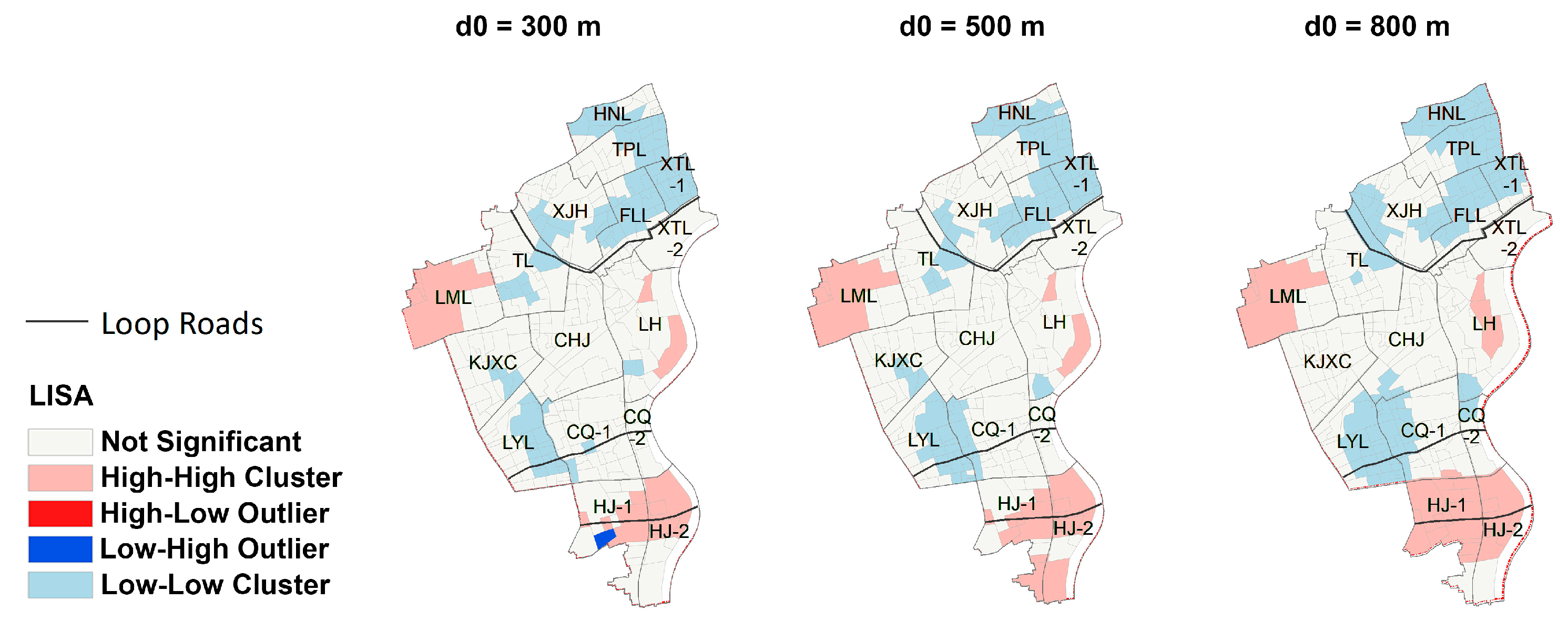
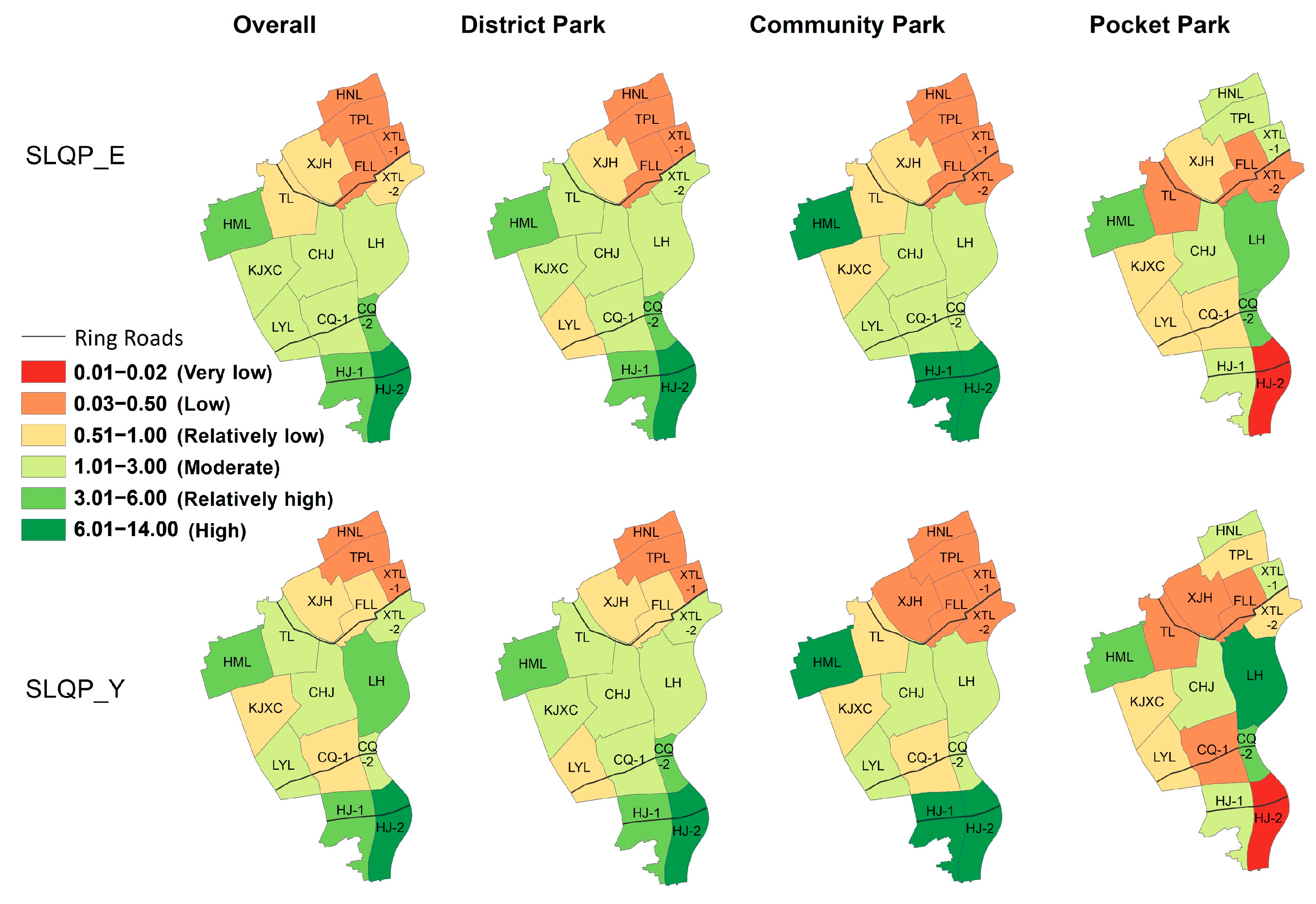

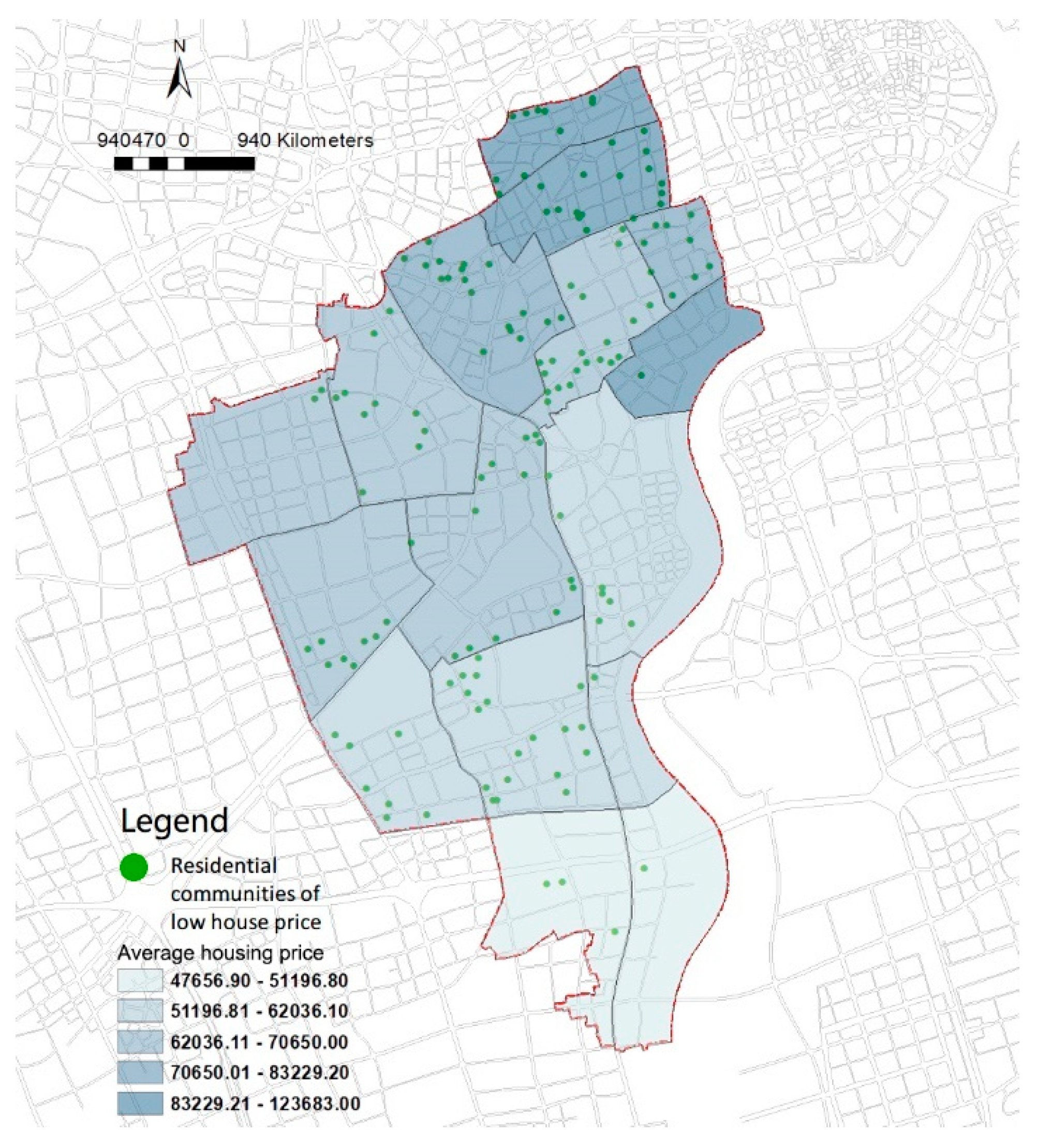
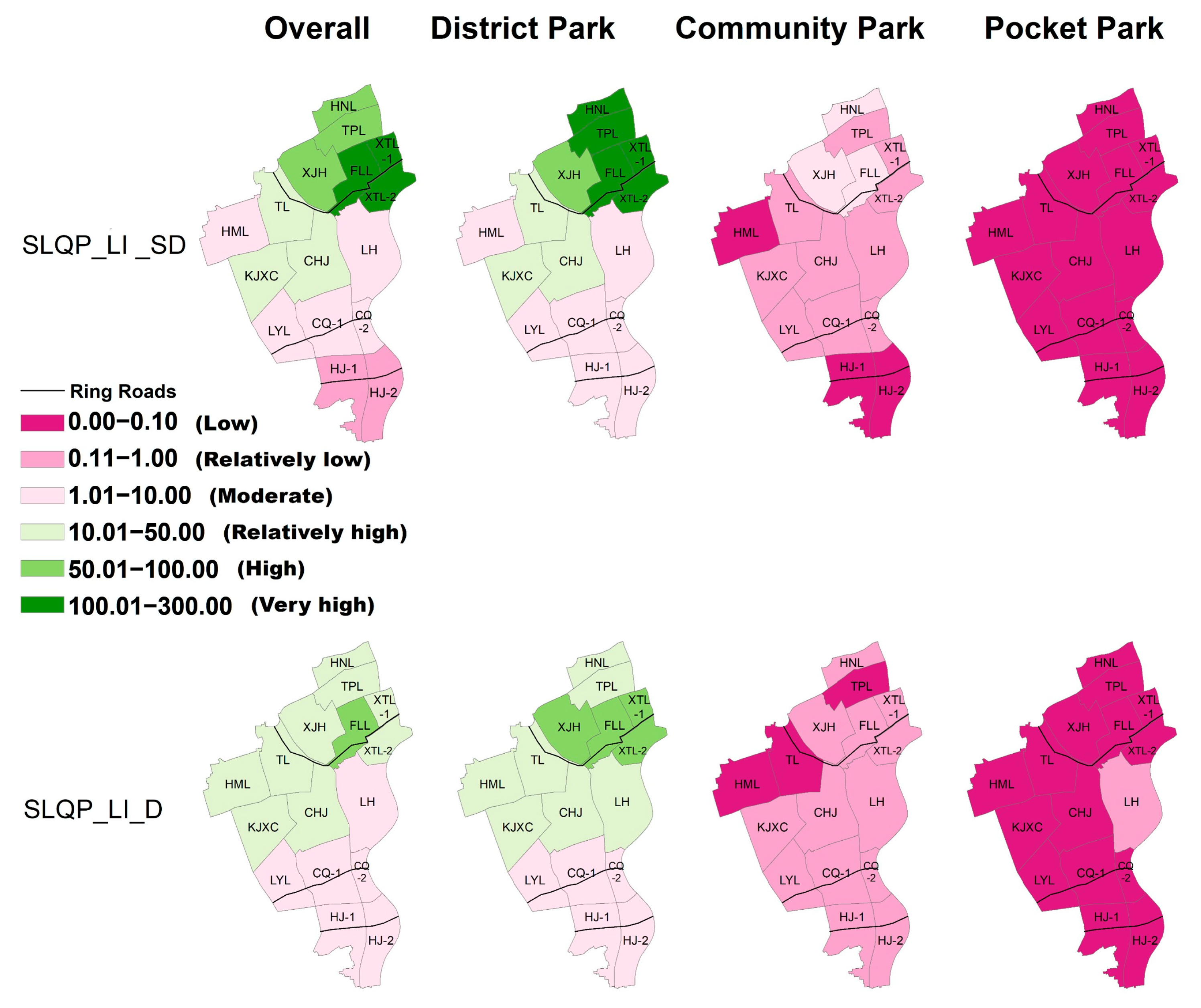
| Category | Number | Area (hm2) | Percentage |
|---|---|---|---|
| Comprehensive Parks * | 1 | / | / |
| District Parks | 15 | 134.06 | 58.82% |
| Community Parks | 111 | 85.77 | 37.63% |
| Pocket Parks | 71 | 8.08 | 3.55% |
| Total | 197 | 227.90 | 100.00% |
Disclaimer/Publisher’s Note: The statements, opinions and data contained in all publications are solely those of the individual author(s) and contributor(s) and not of MDPI and/or the editor(s). MDPI and/or the editor(s) disclaim responsibility for any injury to people or property resulting from any ideas, methods, instructions or products referred to in the content. |
© 2025 by the authors. Licensee MDPI, Basel, Switzerland. This article is an open access article distributed under the terms and conditions of the Creative Commons Attribution (CC BY) license (https://creativecommons.org/licenses/by/4.0/).
Share and Cite
Wang, J.; Jiang, H.; Wang, M.; Xiong, Y.; Zhu, A.; Wang, F. Assessment of Spatial Equality and Social Justice of Urban Park Distribution from Park Category Perspective: Evidence from Shanghai, China. Sustainability 2025, 17, 5474. https://doi.org/10.3390/su17125474
Wang J, Jiang H, Wang M, Xiong Y, Zhu A, Wang F. Assessment of Spatial Equality and Social Justice of Urban Park Distribution from Park Category Perspective: Evidence from Shanghai, China. Sustainability. 2025; 17(12):5474. https://doi.org/10.3390/su17125474
Chicago/Turabian StyleWang, Jieqiong, Huiqing Jiang, Min Wang, Yue Xiong, Anna Zhu, and Fangxinyi Wang. 2025. "Assessment of Spatial Equality and Social Justice of Urban Park Distribution from Park Category Perspective: Evidence from Shanghai, China" Sustainability 17, no. 12: 5474. https://doi.org/10.3390/su17125474
APA StyleWang, J., Jiang, H., Wang, M., Xiong, Y., Zhu, A., & Wang, F. (2025). Assessment of Spatial Equality and Social Justice of Urban Park Distribution from Park Category Perspective: Evidence from Shanghai, China. Sustainability, 17(12), 5474. https://doi.org/10.3390/su17125474






